Monument to Catherine the Great
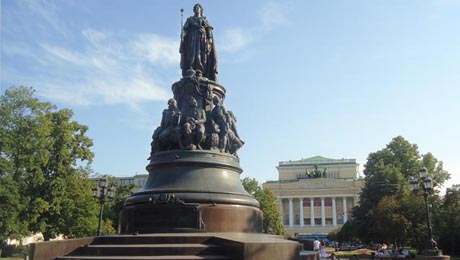
This monument to Catherine the Great was unveiled in 1873. The Empress was adored by the people of St. Petersburg for all her efforts to improve the life and education provided by the city and her reign has long seen been known as the "golden age" of Russia. The statue of Catherine is surrounded by delicately carved figures of the most prominent individuals of her reign: politicians and poets, military men and courtiers. The monument is located in the middle of a small, grass-covered square, just off Nevsky Prospekt, which is lined by the Anichkov Palace, the Alexandrinsky Drama Theater and the Russian National Library. As one of the country's most enlightened monarchs, Catherine could not have chosen a better spot herself.
The Bronze Horseman
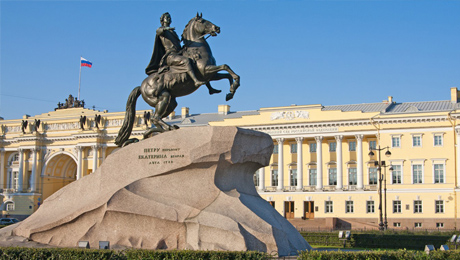
Bronze Horseman on Senatskaya Ploschad is the most famous monument to Peter the Great in St Petersburg, the city that he founded and named. Built in the 18th century, by the beginning of the 19th century the Bronze Horseman was notoriously mentioned in the works of poets and writers of that time. Contrary to its name, the monument is made of copper. The sculpture was commissioned by Catherine II, and according to her plans Peter had to appear as a Roman emperor and a winner with a rod and sceptre in his hand. However, the French sculptor Etienne Falconet, who was invited to work on the monument, dared to argue with the crowned head and showed the world another Peter, without compromising his strategic talents as a wise ruler.
Monument to Peter the Great
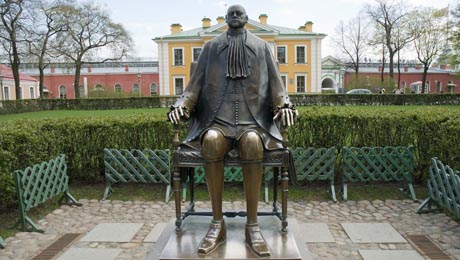
In the 20th century a new square was developed on the site where Dance Square was previously situated. In 1991, a new memorial was erected on this square in the name of the city's founder Peter the Great. The memorial was created by Leningrad artist Mikhail Shemyakin and donated to the city.
The Alexander Column
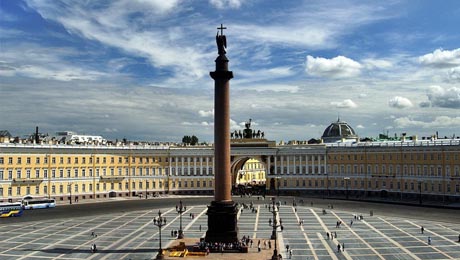
The Alexander Column was erected on Dvortsovaya Ploschad in 1834 by the architect Auguste Montferrand. With a height of 47.5 meters, it signified the victory of the Russian army over Napoleon and France in 1812. The Alexander Column is the tallest column in the world, and is made of a solid stone. It was named after both the Emperor Alexander I, who defeated Napoleon, and the Pharos lighthouse in the Egyptian city of Alexandria, which was one of the seven wonders of the ancient world and embodies the ultimate level of human achievement. The Alexander Column is made of red granite processed in St Petersburg, and weighs 600 tons. It is not dug firmly into the ground, but is held on its weight solely by exact calculations.
Monument to Nicholas I
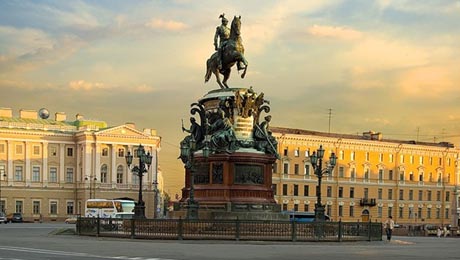
The monument to the iron-willed and notoriously despotic Russian ruler Nicholas I on St. Isaac's Square was built by renowned Russian architect Auguste de Montferrand between 1856 and 1859. Montferrand also built the neighboring St. Isaac's Cathedral. The monument to Nicholas I accurately and powerfully depicts the determined absolutist Russian ruler as a powerful military figure.
Monument to Alexander Pushkin on Ploshchad Iskusstv (Arts Square)
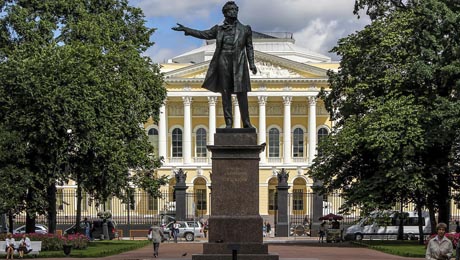
There are several statues of Russia's greatest poet, Alexander Pushkin, in St. Petersburg but the finest of them is probably that which stands in front of the State Russian Museum on Ploshchad Iskusstv. The monument was created by sculptor Mikhail Anikushin and erected in 1957 to mark the 250th anniversary of the founding of St. Petersburg (the city was, of course, founded in 1703 but the death of Joseph Stalin in 1953 delayed celebrations by a full four years).
Statues of Mikhail Kutuzov and Barclay de Tolley
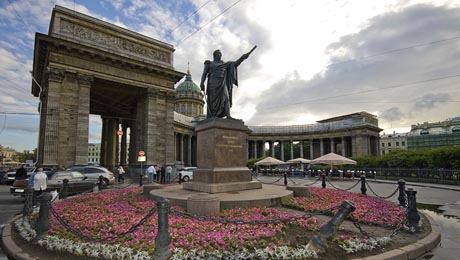
Both Kutuzov and Barclay de Tolley are depicted in their statues in the cannon of Roman Classicism which was fashionable at the time. The sculptor, Boris Orlovsky, dressed both men in togas on top of their military uniforms. Kutuzov is one of the most famous figures in Russia's military history, known above all for his victory over Napoleon at the gates of Moscow in 1812. Barclay de Tolley's role in the victory - it was he who advocated the policy of retreating, adopting scorched-earth tactics and inviting the enemy into the depths of Russia - was not acknowledged at first. When the enemy advanced too far for Emperor Alexander I, he replaced de Tolley with Kutuzov, who followed the plans of his predecessor - and won the war.
Rostral Columns
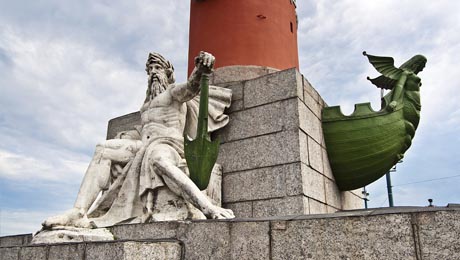
These two columns standing on the Strelka ("spit") of Vasilyevsky Island are as much a symbol of St. Petersburg as the open arches of Palace Bridge, the dome of St. Isaac's Cathedral, or the spires of the Admiralty and the Ss. Peter and Paul Cathedral. For over two centuries, they have formed an integral part of the city's central panorama over the River Neva, and are particularly impressive on major public holidays, when torches are lit on top of them.
The Horse Tamers
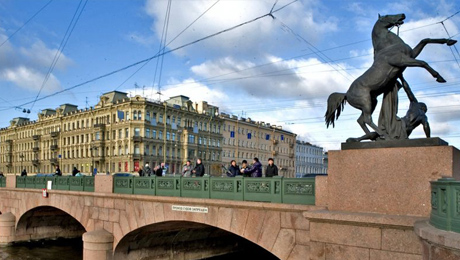
Decorating the Anichkov Bridge, which carries Nevsky Prospekt across the Fontanka River in the very centre of St. Petersburg, the four statues that comprise the sculptural group The Horse Tamers are one of the most strikingly beautiful and immediately recognizable monuments in all of St. Petersburg. Their sculptor, Baron Peter Clodt von Jurgensburg, a former artillery officer of Baltic German descent, had a particular affinity for animals, especially horses, which made him a favourite with Emperor Nicholas I. In the 1830s, he prepared two statues - Horse with Walking Youth and Youth Taking a Horse by the Bridle - for the quay in front of the Academy of Fine Arts. However, that site was chosen for the Ancient Egyptian Sphinxes brought to St. Petersburg in 1834, and Clodt proposed mounting his statues on the western end of Anichkov Bridge.
The Narva Gate
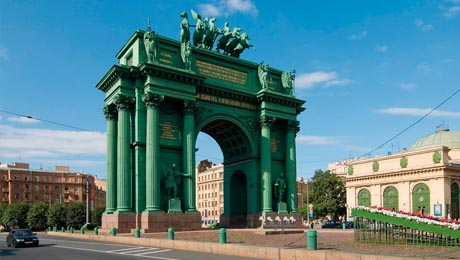
The Narva Triumphal Arch was erected as a memorial to the war of 1812. A wooden triumphal arch designed according to the plan of famous Italian classical architect Dzhakomo Quarenghi. Quarenghi also built the Concert Hall pavilion (1782-88), Alexander Palace in Pushkin (1792-1800) and the Smolny Institute (1806-08) in St. Petersburg. The Narva Triumphal Arch was specially constructed on the Narva highway to greet the soldiers who were returning from abroad after their victory over Napoleon. The arch was located approximately halfway between Ploshchad Stachek and Obvodny Canal.
Sphinxes on Universitetskaya Embankment
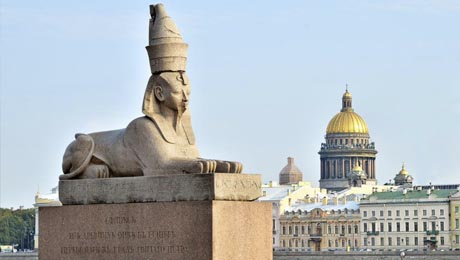
St Petersburg is heavily decorated with many sculptures of various animals, birds and mythological creatures. There are 14 sphinxes in Petersburg, but the most noteworthy sphinxes are located on the Universitetskaya Embankment, opposite the entrance of the Academy of Arts. Only these sculptures were imported directly from Egypt. Scientists believe that their age is approximately 3.5 thousand years. The Russian traveller and diplomat Muravyov saw one of the sphinxes in Alexandria, and was so impressed by what he saw that he appealed to the Russian ambassador and expressed the need to purchase these sculptures for Russia. In the end, his appeal went to Nicholas I, who decided to purchase these unusual sculptures.
Chizhik-Pyzhik
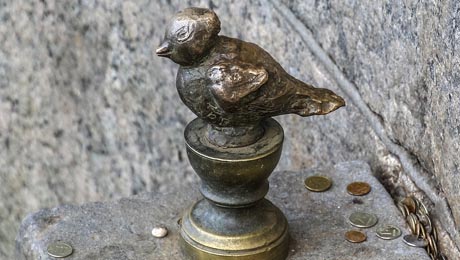
The monument of Chizhik-Pyzhik is an extremely popular monument among tourists of all ages. It was installed on the Fontanka Embankment near the water. Local residents immediately fell in love with the little hero, and soon the belief emerged that if you throw small coins onto a small platform near the bird’s legs their wish will come true. Chizhik-Pyzhik is the smallest monument in St. Petersbourg: with a height of only 11 centimeters and a weight of five kilograms. Due to its small size, the little monument has been stolen more than seven times.
The Hare Escaping Flooding

If you look to your left as you cross Ioannovsky Bridge to the Peter and Paul Fortress, you will see below you on one of the wooden piles in the water a small rather frightened-looking metal hare. This unusual sculpture commemorates the hares that used to live in large numbers on Zaychiy Ostrov ("Hare Island"), the island on which the Peter and Paul Fortress stands. Legend has it that one hare, caught by the rising waters during a flood, saved itself by jumping into Peter the Great's boot as he disembarked from a boat onto the island. This idiosyncratic memorial to the floods that plagued St. Petersburg through the 18th and 19th centuries was erected in 2003 during renovation of Ioannovsky Bridge. The heights of major floods in the history of St. Petersburg are marked on the post beneath the hare.
